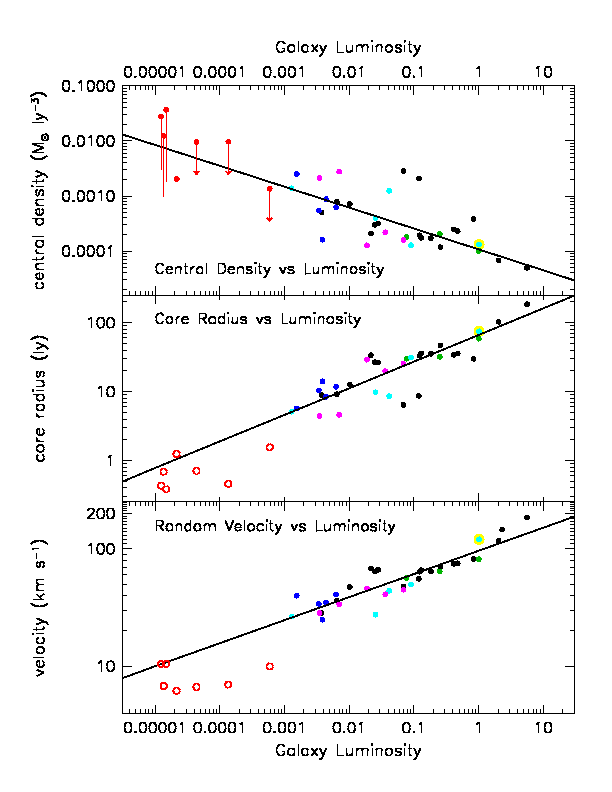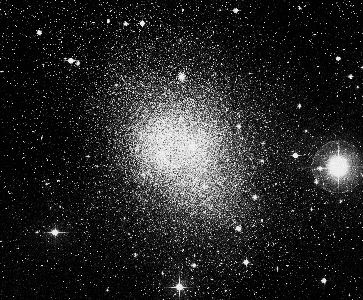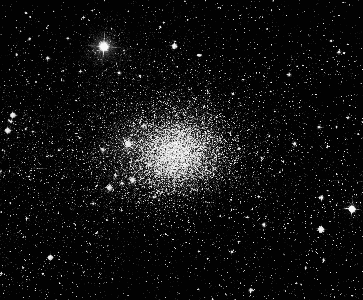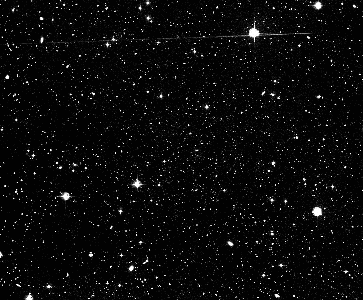
| Scaling Laws for Dark Matter Halos in Late-Type and Dwarf Spheroidal Galaxies |
|---|
AAS 193 (Austin, TX) meeting press release
Astronomical observations show that everything that we have ever seen, including stars and planets, is a small fraction of what there is in the Universe. At least 90% of the Universe is made of something else - of dark matter (DM). We know that it exists only because its gravity pulls on the things we see. But it emits no known form of radiation, so we do not know what it is made of. Many possibilities have been proposed, including elementary particles left over from the Big Bang, underluminous or dead stars, and million-solar-mass black holes. The problem of DM - what it is and how it affects galaxy formation and evolution - is one of the most fundamental puzzles of astronomy.
It is also very slippery. This makes it important to learn as much about DM as we can. It is easiest to study the DM halos of visible galaxies. We have used published mass models fitted to galaxy rotation curves to study the systematic properties of DM halos in late-type and dwarf spheroidal (dSph) galaxies. Halo parameters are derived by fitting non-singular isothermals to (V**2 - Vvis**2)**(1/2), where V(r) is the observed rotation curve and Vvis(r) is the rotation curve of the visible matter. The latter is calculated from the observed hydrogen gas emission and from the optical surface brightness distribution assuming that the mass-to-light ratio M/L is constant with radius. Values of M/L are adjusted to fit as much of the inner rotation curve as possible without making the halo have a hollow core. That is, "maximum disk" decompositions are used. The results are not sensitive to this assumption; similar conclusions are reached (e. g.) if the mass-to-light ratio of the disk is constrained using the observed spiral structure (as in Athanassoula et al. 1987, A&A, 179, 23). To increase the luminosity range, we include dSph galaxies, which are physically related to late-type galaxies.

Combining these data, we find that DM halos satisfy well defined scaling laws analogous to the fundamental plane correlations for elliptical galaxies. Three of these are shown above. Halos in less luminous galaxies have smaller core radii, higher central densities, and higher central velocity dispersions. In the figure, the total luminosity of the galaxy is in units of the luminosity of our Milky Way. The smallest galaxies are extreme dwarfs - these are dSph galaxies with as little as 1/100,000 of the luminosity of our Galaxy (red points). Different colors code the source papers used to get the DM parameters. The yellow-highlighted green point is NGC 5907, which was the subject of a companion press release at the Austin AAS meeting by Liu and Graham. It is a normal giant spiral much like our Galaxy.
Scaling laws provide new and detailed constraints on the nature of DM and on galaxy formation and evolution. Most of these remain to be explored. Some simple implications include:
1. - The surprisingly high DM densities in the dSph galaxies Draco and UMi are normal for galaxies of such low luminosity. This implies that dwarf spheroidals are real galaxies and not just tidal fragments. The reason is that tides stretch, so that bound fragments pulled out of more luminous galaxies would have lower DM densities than their progenitors. But the dark matter is already less dense in giant galaxies than in dwarfs even before tidal stretching. In fact, Barnes and Hernquist (1992, Nature, 360, 715) predict that tidal fragments are able to hold onto essentially no dark matter at all, much less the high-density halos in the above correlations.
If most of these objects are not tidal fragments, then the number of dwarf galaxies is not tied to the limited number of galaxy collisions that have happened since big galaxies formed.
2. - The fact that, as luminosity decreases, dwarf galaxies become more numerous and more nearly dominated by DM raises the possibility that there exists a large population of objects that are completely dark. If so, these empty halos are likely to be small and dense and to have small total masses.
Smaller galaxies are observed to be more dominated by dark matter. The smallest galaxies known are at least 99 % dark. These galaxies look incredibly gossamer, but they are really like cannonballs: they contain a much higher density of dark matter than do giant galaxies. These galaxies did not know when they formed that we would be able to discover them 10 billion years later only if they managed to hold onto 1 % of their mass in stars. Instead, when their first stars died in supernova explosions, they may in many cases have blown away so much of the remaining gas that too few stars were ever formed for us to find the empty halos that are left.
Smaller galaxies are also more numerous; tiny dSph galaxies outnumber large galaxies like our Milky Way. More of them continue to be discovered; clearly we have not found all of them. Since almost-dark galaxies are the most common ones known, darker galaxies may be more common still.




Four increasingly ghostly dSph galaxies are shown above, in UK Schmidt Telescope images taken and kindly provided by David Malin of the Anglo-Australian Observatory. (Upper-left) The Fornax dwarf spheroidal is about 1/1400 as bright as our Galaxy and still very easy to see. (Upper-right) Sculptor is about 1/11000 as bright as our Galaxy; it is noticeably fainter than Fornax, but still easy to discover. (Lower-left) Carina is only 1/56000 as luminous as the Milky Way; it is hard to see but still reconizable at a glance as a cluster of stars. (Lower-right) In contrast, the Sextans dSph, although about the same luminosity as Carina (1/47000 of the Milky Way), is lower in surface brightness and so it is virtually invisible. The stars that are easy to see in this picture are all foreground stars in our Milky Way. Sextans was discovered only recently, by Irwin et al. (1990, MNRAS, 244, 16P), as a slight enhancement of star counts centered in the area shown. This is barely visible, but only in the faintest stars. Each of the above images is clickable to get a larger version.
These images emphasize the contrast between what we see and what is there. We barely see the faintest dwarfs - they contain hardly any stars. But the central dark matter density is about 1 solar mass per 30 cubic light years. This is about 100 times larger than the dark matter density in a giant galaxy and several times larger than the density of stars and gas in the disk of our Milky Way. These dwarfs may look insubstantial, but they are like cannonballs to a giant galaxy.
Their dark matter densities are closely connected with the average density of the Universe when they formed. The high densities of these dwarfs suggest that they formed very early in the history of the Universe, when it was 1/3000 or even 1/10000 as old as it is now. The faintest dwarfs are almost pristine remnants of the earliest time of galaxy formation.
Recent work also shows that smaller galaxies are much more dominated by dark matter. Our Milky Way is a large galaxy, and its main body is about 50% dark. Galaxies with 1/100 of the luminosity of the Milky Way are about 90% dark. The smallest dwarfs that we know about are almost completely dark: only 1% of their matter is in the form of stars. Astronomers believe that they understand why: less massive galaxies have a weaker gravitational hold on their contents, so the first stars that die in supernova explosions eject more of the remaining gas in smaller galaxies. These explosions have little effect on the dark matter. So small galaxies have less gas with which to make stars and therefore low stellar densities despite their high dark matter densities.
The smallest galaxies have so few stars that they are hard to see and harder to discover. But these galaxies do not know that holding onto 1% of their mass in gas is magic - that turning this 1% into stars will allow us to discover them. The first stars that form in many dwarf galaxies may eject so much gas that we cannot find the empty halos that are left.
We caution that our arguments are a prediction and not a proof that dark galaxies must exist. But we hope that our arguments will motivate astronomers to look for them.
Not surprisingly, such objects are exceedingly hard to find. One way may be to look for very low star densities using computerized searches.
This work was supported by NSF grant AST--9219221.
University of Texas Astronomy Home Page
Last update: February 7, 2000
John Kormendy (kormendy@astro.as.utexas.edu)